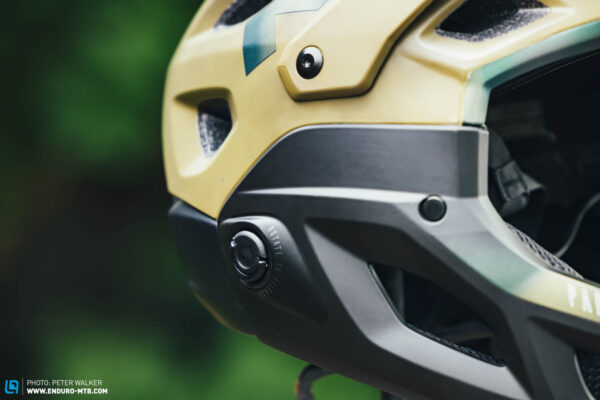Italian helmet manufacturer MET enters the race with the latest iteration of a true classic, the Parachute MCR, a convertible helmet which meets all the safety standards for downhill helmets, and comes equipped with an innovative chin bar mounting system.

The Parachute MCR relies on the same design as MET’s half-shell enduro helmet, the Roam, with the MCR extension standing for Magnetic Chinbar Release. As the name suggests, the chin bar locking mechanism relies on magnets to snap the two connecting parts into place. The chin bar is then secured to the helmet shell with a ratchet-like mechanism, while the magnets only serve as a guide. The Parachute MCR retails at € 350 and tips the scales at 887 g, which makes it the heaviest convertible full-face helmet in this test. That said, the added weight isn’t for nothing – it’s also the only convertible model in this test to comply with the ASTM standard for downhill helmets.
To ensure a good fit, the Parachute relies on a three-position retaining system, which uses a rotary dial to adjust the system’s height. The dial was developed in close collaboration with BOA and therefore employs thin nylon strings rather than wide plastic straps. For additional safety, MET also use a MIPS liner, which is designed to dissipate the rotational forces generated in a crash. The visor is flexible and can be adjusted into two different positions, the higher position allowing room to store your goggles underneath. The Parachute MCR also relies on a magnetic FIDLOCK buckle, which can be easily secured and undone with just one hand.


The MET Parachute MCR provides a comfortable fit for a wide range of head shapes, and at the same time feels extremely secure. While the rear of the helmet sits fairly high, keeping your neck a little cooler, the adjustment mechanism wraps quite far around the head, providing a nice secure fit. With the chin bar installed, it’s the most confidence inspiring helmet amongst the convertible full-face models in this test. Without the chin bar, the Parachute MCR feels slightly burlier than the Bell, but still provides excellent ventilation, proving significantly cooler than the uvex. The chin bar is quick and easy to remove: just turn the two clips and pull the chin bar forward – job done! The system is incredibly intuitive to use, even while you’re wearing the helmet. The main differences between the Parachute’s locking system and the other conversion concepts become evident when you secure the chin bar to the shell. With MET’s system, once you’ve located the two metal pins into their respective eyelets, the magnetic guides make the rest of the process a lot easier. The FIDLOCK chin strap buckle is extremely easy and intuitive to use.
With the Parachute MCR, MET offer a convertible full-face helmet that can be used for a wide range of applications, including downhill, thanks to ASTM certification. From relaxed post-work laps in the half-shell mode to adrenaline-fuelled bike park expeditions in the full-face configuration, the Parachute MCR has your back. However, despite the overall beefy look, the back of the helmet is quite high. The magnetic locking system makes it easy to attach the chin bar, proving the most intuitive conversion concept in the entire test field. The Parachute MCR provides a secure, comfortable fit and inspires huge amounts of confidence.
Tops
- The only convertible helmet in this test certified by ASTM for downhill use
- Intuitive chin bar locking system
- Secure fit
- Good ventilation
Flops
- Short rear shell section
- Quite bulky without the chin bar
For more information, visit met-helmets.com.

For an overview of the group test: 9 lightweight and convertible full-face mountain bike helmets in review
All fullface helmets in test: Bell Super Air R Spherical (Click for review) | Bluegrass Vanguard Core Edition (Click for review) | Fox Proframe RS (Click for review) | Giro Insurgent (Click for review) | MET Parachute MCR | POC Otocon Race MIPS (Click for review) | Specialized Gambit (Click for review) | Troy Lee Designs Stage (Click for review) | Uvex Revolt MIPS (Click for review)

Did you enjoy this article? If so, we would be stoked if you decide to support us with a monthly contribution. By becoming a supporter of ENDURO, you will help secure a sustainable future for high-quality mountain bike journalism. Click here to learn more.
Words: Simon Kohler Photos: Peter Walker









